Snake Behavior and Life History - Defensive Strategies


| Escape Tactics and Threat Displays | ||||||||||||
When threatened, most snakes will simply try to get away from the threat as fast as possible. When they feel a safe escape is not possible, some snakes will rear back and flatten the head into a defensive display that threatens the presumed attacker. Sometimes they will open the mouth in a threat display, and if none of these tactics work, then they may actively strike and even try to bite.These tactics are mostly just a bluff since most snakes do not have venom which is dangerous to humans and their bites, even if they break the skin and cause bleeding, are otherwise harmless. |
||||||||||||
 |
 |
 |
||||||||||
| Tired of being continually picked up and posed, this tiny but gutsy juvenile Mohave Shovel-nosed Snake eventually got angry and struck repeatedly at the camera, as you can see in this short video. | A San Diego Gophersnake is discovered on a dirt road in the morning. It becomes defensive when I follow it, hissing and striking out to warn me to back off in this short video. | This juvenile Two-striped Gartersnake assumed a defensive display when discovered crossing a road at night, flattening its head and hissing. | A California Lyre Snake coils up defensively and strikes in a short video. | |||||||||
 |
 |
 |
 |
|||||||||
| Northwestern Gartersnake with flattened head and open-mouth displays. | Even a tiny snake like this Western Black-headed Snake will open its mouth in a defensive display. | |||||||||||
 |
 |
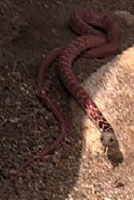 |
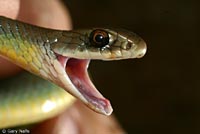 |
|||||||||
| A disgruntled California Kingsnake rears up in a partially-coiled defensive posture, strikes repeatedly at the photographer, then races off a rock to get away in a short video. | A tiny juvenile Common Sharp-tailed Snake with open mouthed defensive display. | Short video I saw this Red Racer foraging in the desert in San Diego County before it saw me. After turning around in my direction, it saw me, raised its head off the ground in a state of alert, wiggled its neck back and forth while holding its head still, then turned around and raced away over the rocks into a bush. The raised-head display may have been a defensive tactic, but the rapid escape was more effective. |
Western Yellow-bellied Racer with open-mouth threat display. I have found that this species will not hesitate to bite in its own defense. | |||||||||
 |
 |
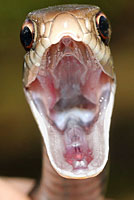 |
 |
|||||||||
| This juvenile Florida Cottonmouth shows the origin of its common name in this open-mouthed threat display which shows the bright white mouth. | North American Racers, Coluber constrictor, are famous for their fierce defensive displays and tendency to bite. This juvenile from Liberty County, Florida is seen in a defensive posture and with open-mouthed display. | |||||||||||
 |
 |
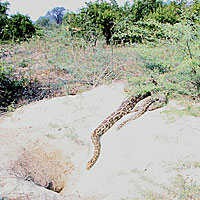 |
 |
|||||||||
| Most Watersnakes, genus Nerodia, such as this Brown Watersnake, bask on branches hanging over water. When the feel threatened, they drop into the water to swim to safety. | In winter, Indian Pythons take advantage of sunny days to bask outside their hibernacula. When threatened, they simply crawl or slide quickly into the hole. These were two of several pythons seen basking and retreating into this hole in January in Rajasthan, India. | Western Ratsnake defensive display, Jefferson County, Kansas | ||||||||||
 |
 |
 |
 |
|||||||||
| Western Ratsnake defensive display, Travis County, Texas. | This Two-striped Gartersnake is puffed up in a defensive pose, with head flattened into a triangular shape, Santa Barbara County @ Jeff Hopkins | This Great Basin Gophersnake is in a high defensive pose, ready to strike. © Noah Morales |
Gophersnakes are often seen basking while stretched out on a sunny road like this Great Basin Gophersnake, with lots of kinks in the body that break up the shape of the body to make it look less like a potential meal to any predatory bird flying above. Sometimes they will stop moving and assume this position when they have been spotted as they are crossing a road. | |||||||||
| Camouflage - Cryptic Colors and Patterns | ||||||||||||
Avoiding detection by a predator is probably the most important weapon in a snake's defensive arsenal. There is a wide variety of snake coloration patterns, sometimes even within the same species. Snakes can be banded, blotched, striped lengthwise, unicolored, or speckled, or a combination of these. These patterns can serve as camouflage when a snake is stationary, where the markings disrupt the form of the snake or match the background. Stripes can help a snake to crawl away quickly because they don't give a predator a reference point to grab onto. Bands can help a snake by disrupting its form when stationary. When a banded snake moves quickly, the bands tend to blend together making the snake look a single color, which makes it difficult for a predator to find a reference point to grab onto. |
||||||||||||
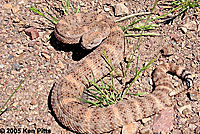 |
 |
 |
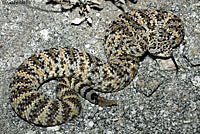 |
|||||||||
| These four differently-colored snakes are all the same species: Southwestern Speckled Rattlesnakes. The coloring of this species matches the color of the rocks in which they live which allows them to hide and avoid detection. This use of cryptic coloring as camouflage is called Crypsis. | ||||||||||||
 |
 |
 |
||||||||||
| Copperheads, such as this Osage Copperhead from Kansas, have a very beautiful and very effective camouflage pattern that helps them to hide in dry leaves. | Most snakes have some kind of cryptic pattern and coloring. The dark body and bright stripes on most gartersnakes, such as these breeding Santa Cruz Gartersnakes, helps them to blend into the long green and brown leaves found in their aquatic habitat. © Zachary Lim |
The dark and light bands of a California Kingsnake act as camouflage by disrupting its form when it is stationary and also help to camouflage it when it moves quickly because the bands tend to merge into a single color when they are in motion, similar to the stripes on a zebra. | ||||||||||
| Defensive Coiling | ||||||||||||
When stretched out, their long thin bodies make snakes easy to catch by grabbing the tail which is too far from the head to be defended. For this reason snakes often coil up when basking and resting in the open. When threatened, some snakes will also coil up into a ball with the head protected inside the coils of the body. |
||||||||||||
 |
 |
 |
||||||||||
| Adult Common Sharp-tailed Snake, coiled into a defensive position that hides its head. | Four Common Sharp-tailed Snakes coiled up in defensive positions. © Jared Heald |
This California Kingsnake has coiled itself into a defensive pose. Its cloaca is opened with the pink insides pushed out, and a foul smell is present. This is all designed to deter a predator while protecting the snake. | This video shows a Long-nosed Snake using a disgusting but effective defensive behavior - it coils up with jerky movements then smears itself with red fluid from its cloaca. After that I certainly did not want to touch the snake again. | |||||||||
 |
 |
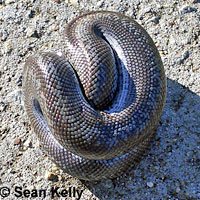 |
 |
|||||||||
| This Texas Nightsnake circled its body into a tight coil and puffed up with air. This makes it difficult to grab onto its body. When picked up, the snake remained tightly coiled. | As you can see in this short video, when they feel threatened, Northern Rubber Boas often curl into a ball with their head hidden in the middle and the tail on the outside, elevated like a head, which it resembles. When a predator attacks what it thinks is a head, it will only injure the tail, which is much less life threatening to the snake. Many rubber boas have scars on their tails from such attacks. | This Rosy Boa is rolled up in a defensive ball. © Sean Kelly | This San Diego Nightsnake is coiled tightly to defend itself. © Tadd Kraft | |||||||||
 |
 |
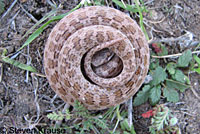 |
 |
|||||||||
| Rattlesnakes, such as this juvenile Northern Pacific Rattlesnake, are often found in a coiled position. This is probably a defensive measure which exposes as little of the body as possible to avoid detection by a predator. © Lou Silva |
This Southwestern Speckled Rattlesnake was found wounded in the middle of a road. It quickly crawled to the center line and coiled up defensively. | A San Diego Nightsnake coils defensively, hiding its head. © Steven Krause. | ||||||||||
 |
 |
 |
||||||||||
| San Diego Nightsnake coiled in defensive pose © Paul Maier | Adult Northern Desert Nightsnake in coiled defensive pose, San Bernardino County © Michael Clarkson | |||||||||||
 |
 |
 |
||||||||||
| This adult Colorado Desert Sidewinder was found coiled up on a rock at night. Rather than coiling defensively, this snake was probably trying to ambush a passing rodent. © Stuart Young |
This juvenile Colorado Desert Sidewinder was found coiled in the sand one evening. Rather than coiling defensively, this snake was probably trying to ambush a passing rodent. | |||||||||||
| Tail Shaking and Rattling | ||||||||||||
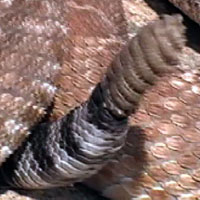 |
 |
 |
 |
|||||||||
| Rattlesnakes are well-known for shaking the rattles on their tails to make a rattling sound which warns of their presence. Each time a rattlesnake sheds, another button is created on the tail. These dry, hollow buttons make a rattling sound when quickly moved back and forth. This rattling behavior might have originally developed as a way to warn large animals not to step on them. In this short video you can see and hear a Red Diamond Rattlesnake rattling. | Click on the play button or the speaker to hear a Mojave Rattlesnake rattling Listen to more rattlesnakes rattling on the rattlesnake page. |
In this short video you can see and hear a distressed Pacific Gophersnake as it shakes its tail rapidly, which makes a buzzing sound as the tail touches the ground. This behavior might be a mimic of a rattlesnake's rattling, or it could be a similar behavior that helps to warn off an animal that could be a threat to the Gophersnake. | In this short video, a distressed striped California Kingsnake vibrates its tail. Similar to the Gophersnake tail shaking, this behavior could also be a behavior that helps to warn an animal that could be a threat to the kingsnake. | |||||||||
 |
 |
|||||||||||
| I spotted a Gray Ratsnake basking in the woods in Tennessee so I turned the video camera on and walked towards it. It moved away slowly and after a few minutes it began to buzz the tip of its tail in the dry leaves to scare me away. This behavior could be an imitation of the rattling of a rattlesnake, or it could just be a defensive behavior similar to that which caused the evolution of the rattlesnake's rattle. | This is a shorter version of the video to the left that shows only the tail buzzing behavior of the ratsnake. | |||||||||||
| Aposematic Coloration (Warning Colors) | ||||||||||||
Conspicuous markings and bright colors warn potential predators not to attack the snake because it is distasteful or poisonous. |
||||||||||||
 |
 |
 |
 |
|||||||||
| Pacific Ring-necked Snake |
San Bernardino Ring-necked Snake | Regal Ring-necked Snake | ||||||||||
| Ring-necked snakes are dull on top, but brightly-colored underneath. When they feel threatened, they emit a foul smell from their vent, and coil their tail into a spiral showing the bright red coloring. This act is called an Unkenreflex. The warning coloring (usually red) is called Aposematic coloring, and is designed to advertise to a potential predator that the snake is not safe to eat. Sometimes this is a trick used by harmless animals (called Batesian mimicry.) |
||||||||||||
 |
 |
 |
 |
|||||||||
This Arizona Coral Snake is writhing its body, crooking its neck, curling its tail and popping its cloaca, all to threaten or frighten away what it perceives to be an enemy - in this case, the photographer. It's bright coloring also serves as a warning that this snake has potentially lethal venom. |
The bright coloring of a California Mountain Kingsnake serve as a warning and possibly derived as a mimic of a coral snake's coloring - an example of Batesian mimicry. | Arizona Mountain Kingsnakes are also Coral Snake mimics. | ||||||||||
 |
 |
 |
 |
|||||||||
| The bright colors of a Gray-banded Kingsnake probably also serve as a trick of Batesian mimicry. | The Western Milksnake is another Coral Snake mimic. | This Western Milksnake is another Coral Snake mimic. | This Western Milksnake is another Coral Snake mimic. | |||||||||
 |
 |
|||||||||||
| The bright colors of this Tucson Shovel-nosed Snake may serve as a warning or as a Coral Snake mimic. | The bright colors of this Colorado Desert Shovel-nosed snake may serve as a warning or as a Coral Snake mimic. | |||||||||||
| Musking - Releasing Foul-smelling Distasteful Fluids | ||||||||||||
 |
 |
 |
 |
|||||||||
| San Diego County adult Long-nosed Snake exhibiting "cloacal auto-hemorrhage" behavior where it smears cloacal blood all over itself to deter attacks. | This short video shows a Long-nosed Snake using a disgusting but effective defensive behavior - it coils up with jerky movements then smears itself with red fluid from its cloaca. After that I certainly did not want to touch the snake again. | A Long-nosed Snake in a defensive position after having smeared itself with blood. © William Flaxington | Lassen County adult Long-nosed Snakeauto-hemmhoraging. © Don Cain | |||||||||
 |
 |
 |
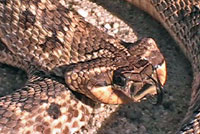 |
|||||||||
| Many snakes squirt and smear a foul-smelling fluid consisting of feces, uric acid, and anal gland musk from their cloaca to deter a predator or a grabby photographer. In this short video, after it is picked up, a big adult Diablo Range Gartersnake demonstrates how it smears its nasty-smelling stuff all over me. You are fortunate that they haven't invented online video with smells yet. | Besides the video to the left, I don't have any other examples of gartersnakes musking, but almost every gartersnake I have picked up has responded with a handful of stinky fluid. | When threatened, Hog-nosed snakes, like this Mexican Hog-nosed Snake, roll over exposing their bellies and play dead, with their mouth open and their tongue hanging out. If picked up, they may roll back over onto their back. They will also flatten their neck like a Cobra, puff up their body, and hiss and strike at their assailant. But their most effective defensive tactic, in my experience, is when they curl up their tail and smear their own foul-smelling feces on their body, as you can see here. | In this short video, we see a Mexican Hog-nosed Snake that was found stretched out on a road. It goes into a defensive coil, smearing its feces on itself and hissing and striking, before crawling away and down a hole. | |||||||||
 |
||||||||||||
| Threadsnakes, formerly called Blind Snakes, often writhe around forming a tight coil while releasing pungent fluids from the cloaca. These fluids serve to repel defensive attacks by the ants and termites on which it feeds. Some of the sticky fluid is visible on the Desert Threadsnake seen here. | ||||||||||||
| Rattlesnake Defensive Displays | ||||||||||||
Like most snakes, rattlesnakes use a variety of defensive tactics, including simply trying to escape and hide. When that is not thought possible, they will stand their ground in a defensive posture with the body raised up ready to strike forward, while shaking the rattle on the end of their tail as a warning. Sometimes the display includes striking and even biting and painful if not fatal envenomation if the predator is close. |
||||||||||||
 |
 |
 |
 |
|||||||||
| When they feel they need to defend themselves, Western Diamond-backed Rattlesnakes often assume a very impressive threatening posture with the head raised off the ground, often accompanied by tail rattling and hissing. | Northern Mohave Rattlesnake in a defensive threatening posture. © Tim Burkhardt |
Rattlesnakes are well-known for shaking the rattles on their tails to make a rattling sound which warns of their presence. Each time a rattlesnake sheds, another button is created on the tail. These dry, hollow buttons make a rattling sound when quickly moved back and forth. This rattling behavior might have originally developed as a way to warn large animals not to step on them. In this short video you can see and hear a Red Diamond Rattlesnake rattling. | ||||||||||
 |
 |
 |
 |
|||||||||
| Northern Pacific Rattlesnake defense pose, Santa Clara County © John Worden |
Northern Pacific Rattlesnake defense pose, Tulare County. © Ken D. Wiley | A Southern Pacific Rattlesnake defensive display. | I spotted this Great Basin Rattlesnake crawling across a road in the afternoon. When it saw that I was aware of it, it crawled under a bush, coiled up and continued rattling, which you can see in this short video. I could hear it still rattling as I drove away from it around 30 minutes later. | |||||||||
 |
 |
 |
 |
|||||||||
| A short video with several views of a Northern Mohave Rattlesnake rattling and taking a defensive posture. | This short video shows a Northern Pacific Rattlesnake that crossed a mountain road on a windy spring morning in Contra Costa County then coiled defensively at the edge of the road. Concerned with my presence a few yards away, it is seen here sensing the air with its tongue and rattling its tail, then pausing to watch a bicycle speed down the road, then rattling some more. | A Southern Pacific Rattlesnake poses and rattles and crawls away at night in Los Angeles Count in this short video.. | A Northern Pacific Rattlesnake in the Sierra Nevada mountains crawls into a crack and shakes its tail in this short video. | |||||||||
 |
 |
 |
||||||||||
| Upon detection, this Southwestern Speckled Rattlesnake crawled up into a bush where it sat and rattled, as you can see in this short video. | Rattlesnakes will frequently try to escape by crawling under rocks or bushes rather than stand their ground in an aggressive-looking defensive display. This Southwestern Speckled Rattlesnake did just that. (Some loud background noise has been deleted in the middle of this short video.) |
A Western Diamond-backed Rattlesnake in New Mexico rattles in a defensive pose in a short video. | ||||||||||
| Gophersnake Defensive Displays | ||||||||||||
Many wild Gophersnakes offer little resistance when they are approached or picked up by a curious human, but if they feel threatened they will sometimes coil up, hiss loudly, strike repeatedly, and vibrate their tail. Unfortunately, this dramatic display probably encourages humans to kill them because they appear so threatening and so much like a rattlesnake. If you get too close to this display, a Gophersnake will bite. Their teeth can puncture the skin but Gophersnakes have no venom so their bite is otherwise harmless. |
||||||||||||
 |
 |
 |
 |
|||||||||
| Short video Gophersnakes are not venomous, but in the wild they often take a vicious defensive stance when they feel threatened; they puff up their body, hiss loudly, elevate the head and neck, and sometimes even strike at the threat in order to protect themselves from harm. In this video, a newly-hatched juvenile Sonoran Gophersnake found trying to cross a road at night is threatened by the bright light and the video camera stuck in its face so it hisses loudly and strikes at the camera before crawling away to safety unharmed. Yes, the camera survived, also. |
This is another mad Gophersnake video. After I rescued this Pacific Gophersnake from oncoming traffic, what thanks did I get? - a very nice show of its defensive arsenal - coiling, puffing up and elevating the body, flattening the head into a triangular shape, hissing loudly, shaking the tail, and striking repeatedly. When I back off, the snake crawls away, keeping its head and neck defensively arched, ready to strike quickly if necessary. Ignore the cry of pain you hear: No photographers were seriously injured in the making of this film. |
A huge Sonoran Gophersnake puts on an impressive defensive display of hissing and blowing in this short video. | A San Diego Gophersnake is discovered on a dirt road in the morning. It becomes defensive when I follow it, hissing and striking out to warn me to back off in this short video. | |||||||||
 |
 |
 |
 |
|||||||||
| Adult Pacific Gophersnake defensive pose, El Dorado County © Tyler Young | Adult Pacific Gophersnake in defensive pose, Kings County © Patrick Briggs | In this short video you can see and hear a distressed Pacific Gophersnake as it shakes its tail rapidly, which makes a buzzing sound as the tail touches the ground. This behavior might be a mimic of a rattlesnake's rattling, or it could be a similar behavior that helps to warn off an animal that could be a threat to the Gophersnake. | ||||||||||
 |
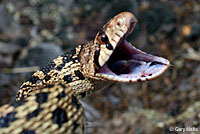 |
 |
||||||||||
| A large Bullsnake rears back in a defensive striking posture, then strikes with a loud hiss, and continues to make a rattling hissing sound. | Their bite is harmless, but these snakes will not hesitate to bite to defend themselves. | This adult San Diego Gophersnake is displaying a typical gophersnake defensive posture with the head flattened into a triangular shape and the body semi-coiled, which resemble a defensive rattlesnake. Typically a gophersnake will also hiss loudlhy and shake its tail to make a rattling sound in dry leaves. © Michael Van Zandt |
||||||||||
| Hog-nosed Snake Defensive Display with Hissing, Playing Dead, and Musking | ||||||||||||
 |
 |
 |
 |
|||||||||
| When threatened, Hog-nosed snakes, like this Mexican Hog-nosed Snake, roll over exposing their bellies and play dead, with their mouth open and their tongue hanging out. If picked up, they may roll back over onto their back. They will also flatten their neck like a Cobra, puff up their body, and hiss and strike at their assailant. But their most effective defensive tactic, in my experience, is when they curl up their tail and smear their own foul-smelling feces on their body, as you can see in the picture on the right. | In this short video, a Mexican Hog-nosed Snake blows and hisses and strikes. | Hog-nosed snakes are well-known for their strategy of rolling over and playing dead to dissuade a predator. (This faking death is called "thanatosis".) In this short video you can see one roll over and play dead, then use a combination of playing dead and hissing. | ||||||||||
Return to the Top
© 2000 -


